APA Creators Draw on Myth and Folklore to Craft Personal, yet Universal Stories
Rewriting and subverting the familiar has been a literary trope for centuries. These authors found inspiration in their Asian heritage, and their books exemplify a fluidity of countries, cultures, and identities.
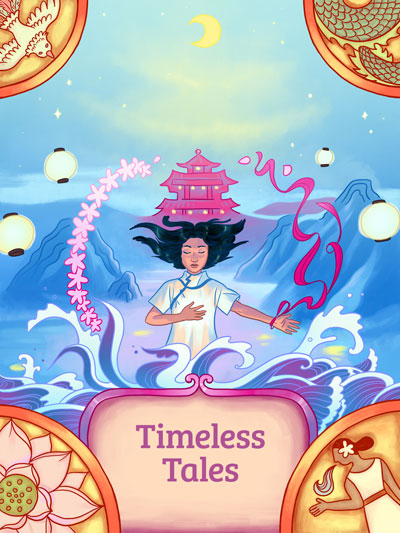 |
Illustration by Yao Xiao |
|
Also Read: |
Welcome to one of the more hope-filled, albeit cautious, Asian Pacific American (APA) Heritage Months in recent history. Plenty remains unsettled, challenging, and tragic, but a glass-half-full outlook extols the news that the world is finally, excitedly opening up from the last two-plus years of pandemic isolation. For the APA community, that reemergence comes with vigilance following the alarming surge in anti-Asian hate crimes. As antidotes to and balms against racism and phobias, stories can help soothe, support, and strengthen.
Among stories that enlighten and entertain are myths and folklore that encapsulate perennially recognizable, universal narratives. Rewriting and subverting the familiar has been a literary trope for centuries. Folklore and fairy tales provide particularly fertile sources for reinterpretations and retellings exactly because of their universal appeal—Cinderella-esque tales, for example, are ubiquitously worldwide.
Other mythical elements, however, have remained culturally and geographically specific. To explore Asian folklore–inspired titles, we caught up with four authors (and one translator) whose recent titles found inspiration in their Asian heritage, their titles exemplifying a fluidity of countries, cultures, and identities. Their biographies exactly encapsulate the APA acronym: A for Asian is Sachiko Kashiwaba, the Japanese writer of the latest Mildred L. Batchelder Award–winning Temple Alley Summer, gratefully English-enabled by Avery Fischer Udagawa; P for Pacific Islander is Hinaleimoana Wong-Kalu, the native Hawaiian author of Kapaemahu; A for Americans are Trung Le Nguyen, the Vietnamese American refugee creator of The Magic Fish, and Axie Oh, the U.S.–born Korean American writer of The Girl Who Fell Beneath the Sea. Each of their books deftly reflect Asian myth and folklore in their narratives; each prove to be illuminating celebrations of the lifesaving power of storytelling.
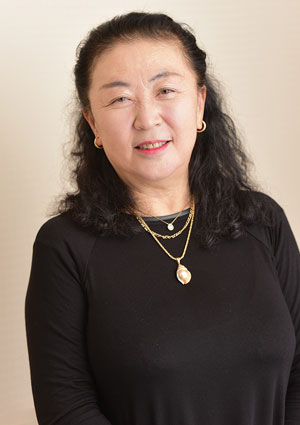 |
Sachiko KashiwabaPhoto by © Kodansha Ltd |
In her magical Temple Alley Summer (2021), Kashiwaba introduces young protagonist Kazu who is very much alive, but he’s not so sure about an apparition he sees one night slipping out of his family’s home. The next morning, she’s there in his classroom, somehow a familiar friend to all his classmates as Akari—yet spectral only to Kazu. Via translator Udagawa, Kashiwaba explains an initial impetus for Temple was the “small guardian Buddha Jizō [that] was being honored on the altar in [her] parents’ home.” In the traditional Japanese mythic world, Jizō is the protector of children, especially those who have died. From Kazu and Akari’s otherworldly friendship, Kashiwaba builds a multilayered delight, a mysterious quest that further weaves an unfinished-story-within-a-story involving a lost prince and an evil witch.
Although Kashiwaba has published over 100 titles in her native Japan, Temple Alley Summer is her first to arrive stateside in translation. Western readers might not yet know her name, but many are familiar with legendary animator Hayao Miyazaki’s film Spirited Away, which was based on Kashiwaba’s novel The Marvelous Village Veiled in Mist.
Her 2022 Batchelder win for Temple Alley Summer, recognizing an outstanding children’s book from outside of the United States and originally published in another language, prompted another stateside import, The House of the Lost on the Cape. Originally published in 2015 in Japan, it’s already been adapted into a 2021 anime film. Kashiwaba continues to draw on local folklore in Cape, also translated by Udagawa, and due in the U.S. in 2023.
“Many characters from the Tōno Monogatari make an appearance,” Kashiwaba explains, a reference to a classic collection of myths and legends from Japan’s Tōno region; Kashiwaba edited a children’s version of Tōno Monogatari in 2016. “These mysterious stories made me want to slip the same delights and shivers and questions into readers’ hearts with the stories I made.”
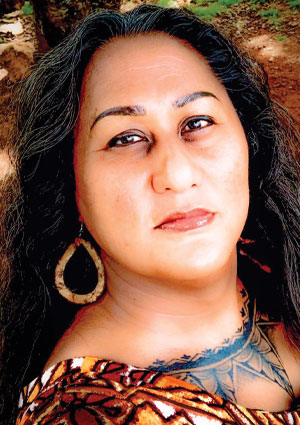 |
Hinaleimoana Wong-Kalu |
Moving across the Pacific to Hawaii finds Hinaleimoana Wong-Kalu, the co-creator, with Dean Hamer and Joe Wilson, of the glorious picture book Kapaemahu (2022). The mythic legend of the Kapaemahu regales four Tahitian healers who arrived in Waikiki centuries ago. Neither male nor female, “they were mahu—a mixture of both in mind, heart, and spirit,” the book reveals. The people built a monument in gratitude, but the “four great boulders” eventually disappeared in the wake of U.S. colonialism and destructive tourism. The stones were finally recovered, but without their history: “The fact that the healers were mahu has been erased.” Kapaemahu reclaims the monument’s true origins by honoring the mahu.
Before the book, Kapaemahu was an animated short film that garnered international acclaim, including a 2021 Oscars short list nod. The film’s production team adapted their gorgeous moving images to the page. The book, like the film, is bilingual, presented in Olelo Niihau first, followed by the English translation. Olelo Niihau, Wong-Kalu explains in the author’s note, is “the only form of Hawaiian that has been continuously spoken since prior to the arrival of foreigners.” Wong-Kalu, who is “Kanaka—a native person descended from the original inhabitants of the islands of Hawaii,” rightfully insists, “We need to be active participants in telling our own stories in our own way.”
Like many native Hawaiian youth of her generation and generations that followed, Wong-Kalu “didn’t grow up with the presence of Hawaiian history and culture,” she says. Her broader education that began in the late 1990s at the University of Hawai’i at Manoa “cumulatively heightened [her] awareness of being Hawaiian,” including discovering the legend of Kapaemahu. Wong-Kalu, too, is neither male nor female, but mahu. “It was quite liberating to learn that something associated with mahu was so positive,” she says.
For Wong-Kalu, claiming and preserving her native heritage in a climate of cultural erasure is of critical importance: “Evidence of anything Hawaiian is fleeting or at least diminished greatly—the history of Hawaii continues to be rewritten by foreigners who are replacing our story with their story,” she says. With Kapaemahu, Wong-Kalu fights back: “I view the telling of this story as a stepping-stone to inspire others to tell their stories and histories.”

Identity—explored through myths and legends—is at the core of Nguyen’s The Magic Fish (2020), a multilayered graphic novel enhanced with story-within-stories interwoven into a coming-of-age narrative about young Vietnamese American Tien attempting to impart a secret to his mother. When communication falters, sharing the language of fairy tales emboldens difficult conversations.
“Storytelling was everywhere for me growing up,” Nguyen says. Born in a refugee camp in the Philippines, he arrived as a toddler with his parents in the United States. “I grew up reading and loving a lot of these Western stories, and the Vietnamese ones happened by me through my parents,’ he says. “Absorbing stories somewhere between the highly curated tales in books and oral tradition stories really gave me the sense that all these stories are valid and gorgeous in their little inconsistencies and differences.”
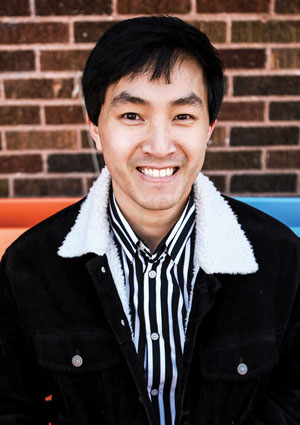 |
Trung Le NguyenPhoto by Laura Duholm |
Three parallel stories reflect that amalgam of East and West in Magic, featuring an adaptation of Vietnamese Cinderella, Tam Cám; a fairy godparent-like magic fish; and a voiceless mermaid who learns to speak through dance. “As I got older…I loved revisiting old, illustrated fairy-tale books,” Trung says. “Fairy tales emerged as an incredibly important way for me to contextualize culture at large.” Magic is his tangible alchemy. “We see familiar stories change clothes and shift priorities in order to subsist in new places,” he says. “In fairy tales, the storytellers interest me more than the stories themselves, because we all tell on ourselves when we tell stories. An exchange of a story is an act of confession. Stories change as we do.”
For Korean American Oh, adapting the traditional Korean “Tale of Shim Cheong” became the basis of her latest YA novel, The Girl Who Fell Beneath the Sea (2022), her first foray into exploring folklore, after writing dystopic fantasy and contemporary romance. “Shim Cheong” includes a determined heroine willing to sacrifice her life to save her family; Oh approached the classic tale as a “jumping start rather than a straight retelling.” Oh’s version features 16-year-old Mina who, unwilling to watch her adored older brother lose his beloved Shim Cheong, replaces herself as the sacrificial bride of the Sea God. Waking in the Spirit Realm, Mina must reunite with her lost soul while figuring out how to save her earthly people.
Born in New York to Korean immigrant parents, Oh had the privilege of growing up without the pressure of having to differentiate her dual heritage: “It was a blend of culture, and I felt very proud and safe in my Korean American identity at home, and within myself,” she says. As a child, she had access to Korean myths and folklore through books in translation. She “loved to read,” including “a lot of fairy-tale retellings, like Beauty by Robin McKinley and Wildwood Dancing by Juliet Marillier, and so it was always a dream of mine to do a fairy-tale retelling in a similar vein but with my Korean heritage.”
Like Kashiwaba and Nguyen, Oh is also adept at nesting stories. She inserts three more Korean-inspired folktales into The Girl Who Fell Beneath the Sea, “purposely chosen in order to fit a message Mina is trying to convey in telling those tales.” In combining historical folklore, magical elements, mythological creatures—including imugi, Korean proto-dragons that she first discovered in a video game—Oh invents her own myths: “I first and foremost wanted to prioritize that Girl is a fun fantasy novel. I definitely adapted freely and by whim and intuition and genuine love for Korean culture but also my love of the fantasy genre. I took a lot of liberties with the original folktales, but hopefully kept the spirit of all of them.”
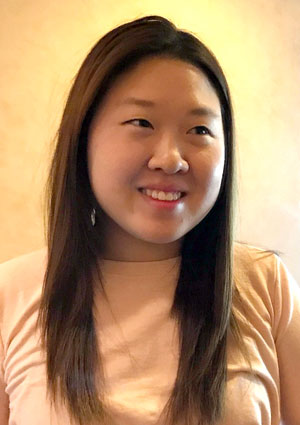 |
Axie Oh |
When is “universal” not so?
Folklore and myths provide timeless inspiration because they share a universal appeal regardless of originating background. Kashiwaba, Wong-Kalu, Nguyen, and Oh distilled that universality to create their own resonating narratives; each author chose culture-specific stories that align with their identities. As publishing encourages and supports (even demands) greater cultural respect and awareness, their books would certainly be stamped “authentic.” And yet that term has become a prominent, sometimes dangerous, buzzword; so, too, has “appropriation.”
“The discourse about appropriation is so frequently reduced to questions about who is or is not allowed to write what, and I don’t think that’s the point,” says Nguyen. “Culture shifts and reacts to the people in and around it. It can’t be treated like a calcified artifact.” Both Wong-Kalu and Oh acknowledge, respectively, examples of non-Hawaiian and non-Korean authors whose writings featuring traditional tales were influential to their own exposure: Puakea Nogelmeier, linguistic University of Hawai’i scholar (now retired) for Wong-Kalu, and folklorist Frances Carpenter, well remembered for her global “Grandmother” collections, including Tales of a Korean Grandmother, which sat on Oh’s childhood shelves.
“The oversimplification of discussions around misappropriation hits me, as a diasporic creator, very strangely,” say Nguyen. “Many times over the course of writing The Magic Fish, I brushed up against this feeling that I wasn’t qualified to write about my own Vietnameseness because I was unfamiliar with the country and the culture as it once was. Was I misappropriating Vietnameseness as an American? Am I less American if I’m committed to exploring my Vietnameseness?”
“I think that genuine love and reverence for a folktale shows in the telling of the folktale and that usually comes with a connection to the source, which is why I personally enjoy reading adaptations of culture-specific stories from people who share that culture,” adds Oh. A hybrid balance seems to be her sweet spot: “As a Korean American author who grew up in the West, I also incorporate a lot of Western viewpoints into my storytelling as well, and I think that blend is my unique viewpoint.”
Terry Hong created “Smithsonian BookDragon,” a book blog for the Smithsonian Asian Pacific American Center.
RELATED
The job outlook in 2030: Librarians will be in demand
The job outlook in 2030: Librarians will be in demand
ALREADY A SUBSCRIBER? LOG IN
We are currently offering this content for free. Sign up now to activate your personal profile, where you can save articles for future viewing





Add Comment :-
Be the first reader to comment.
Comment Policy:
Comment should not be empty !!!